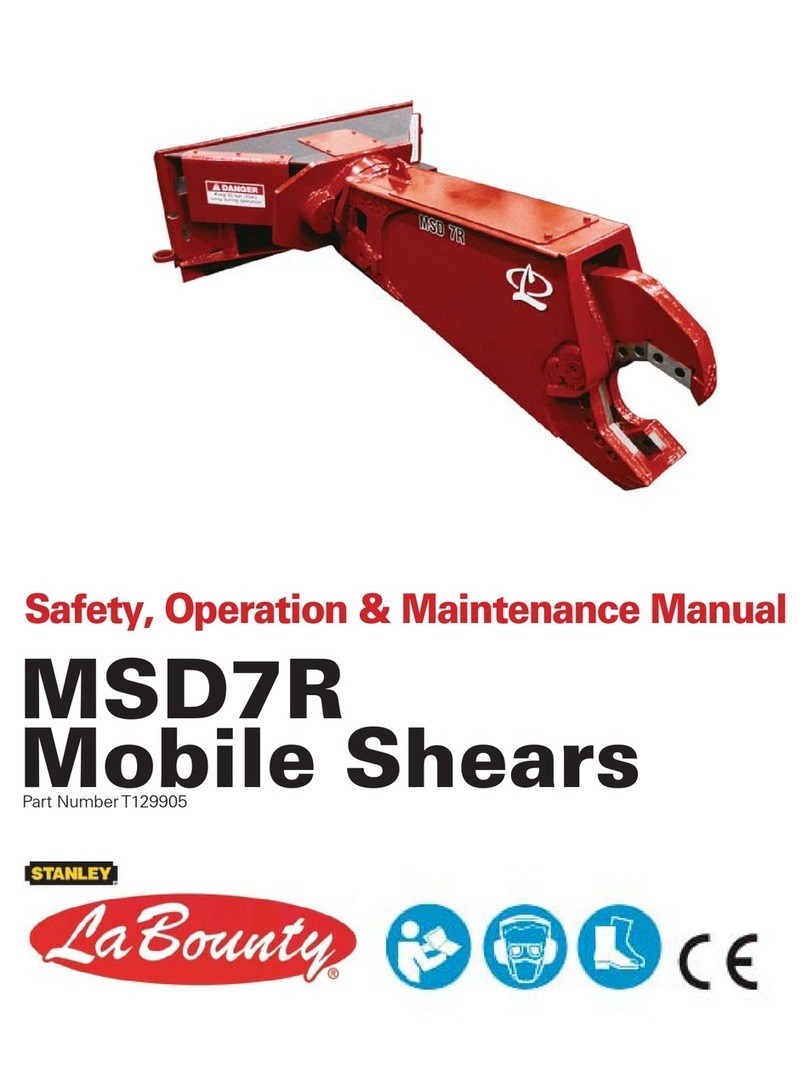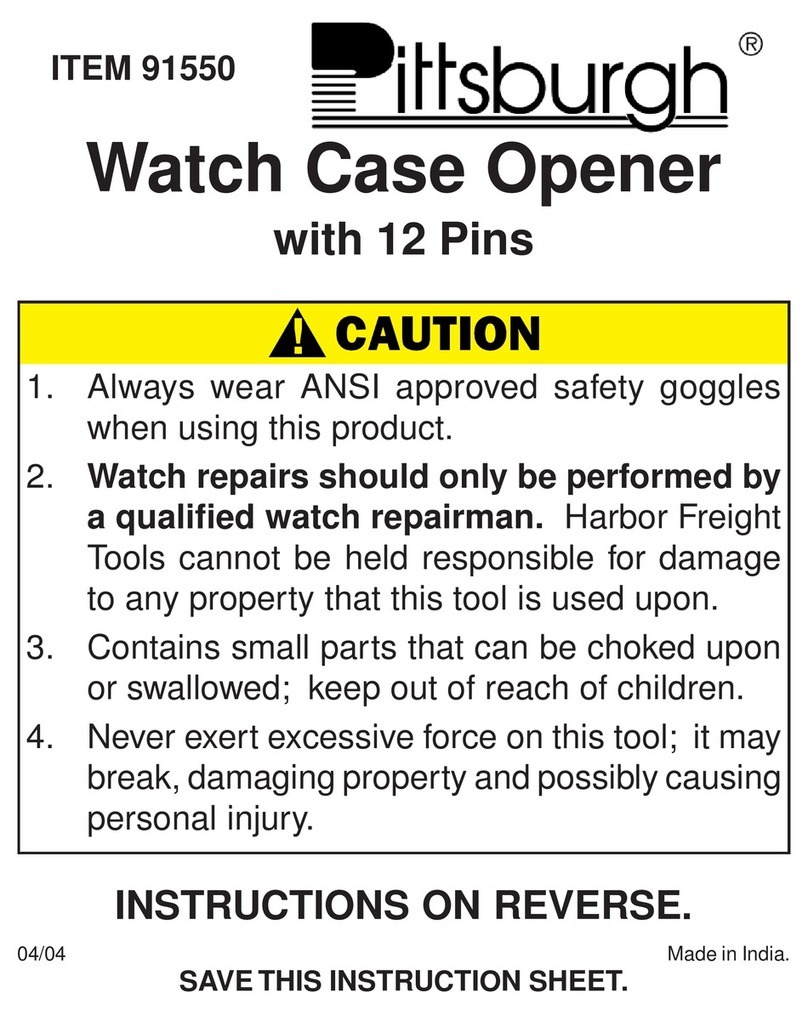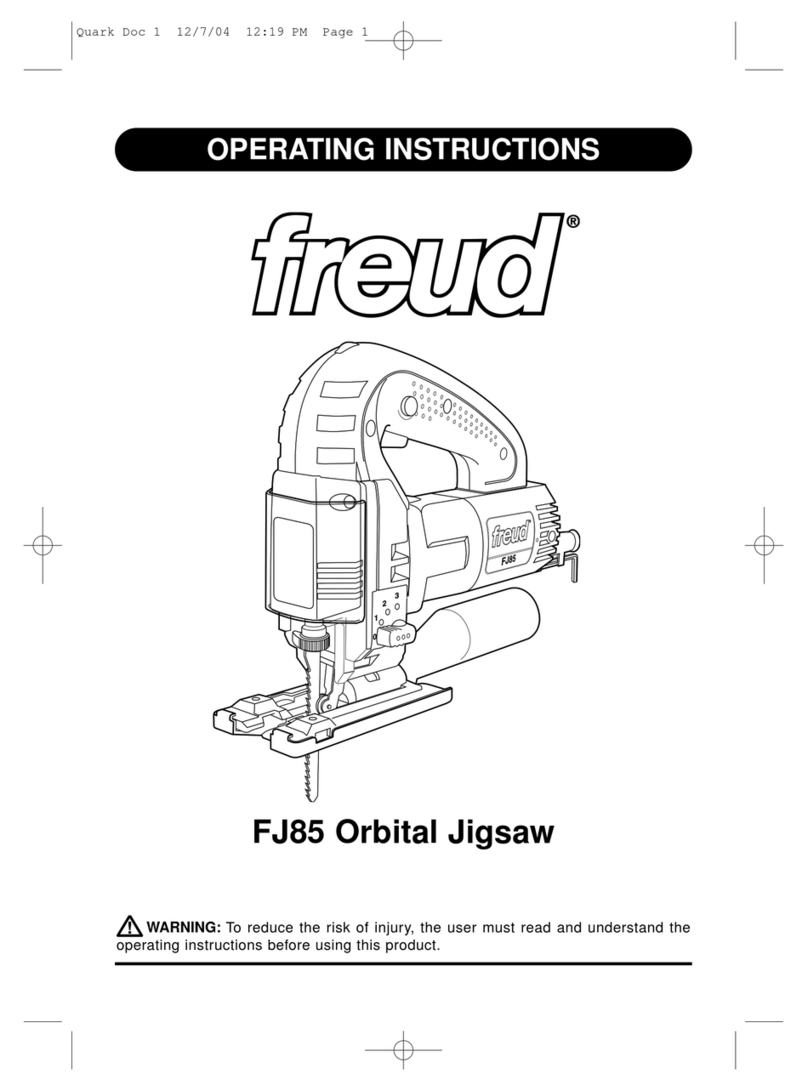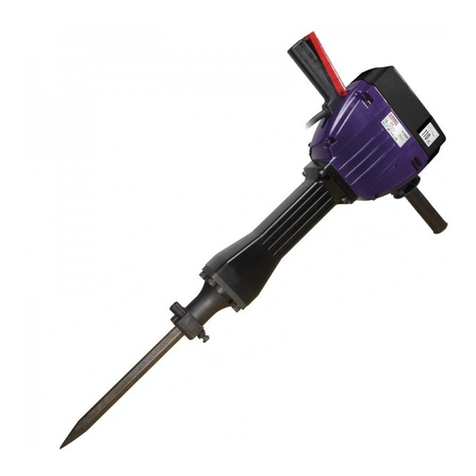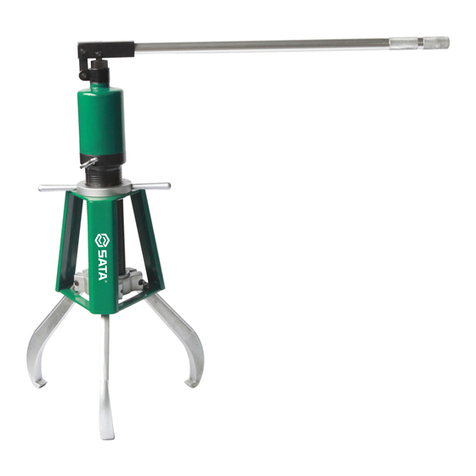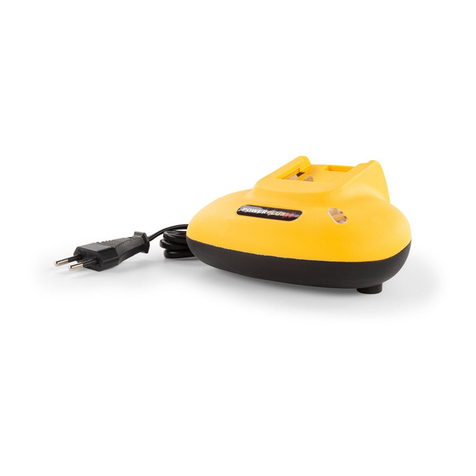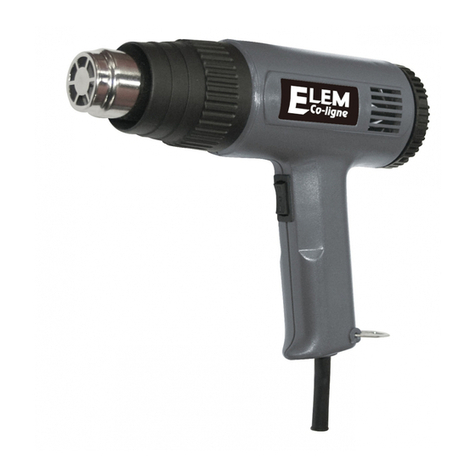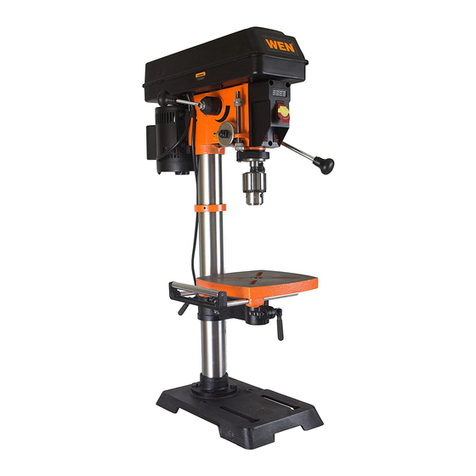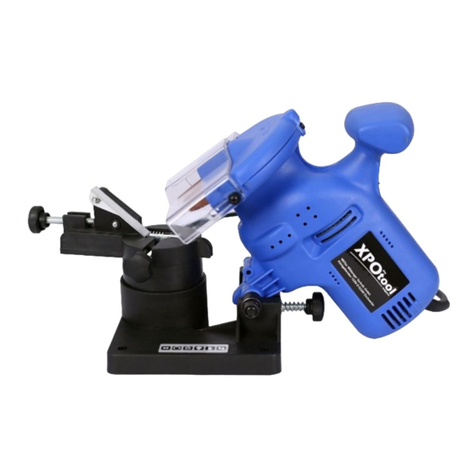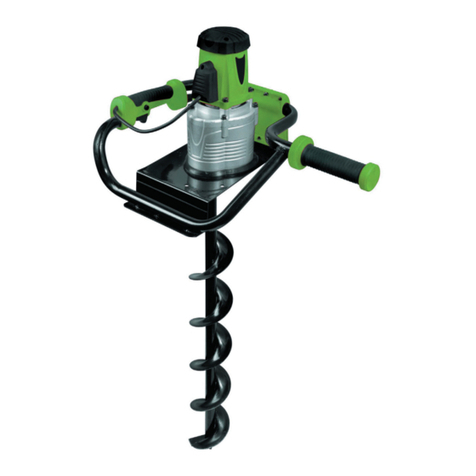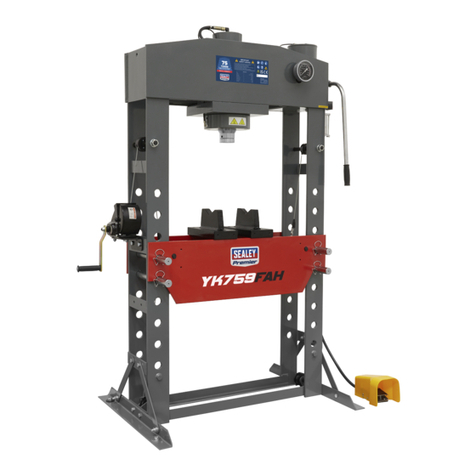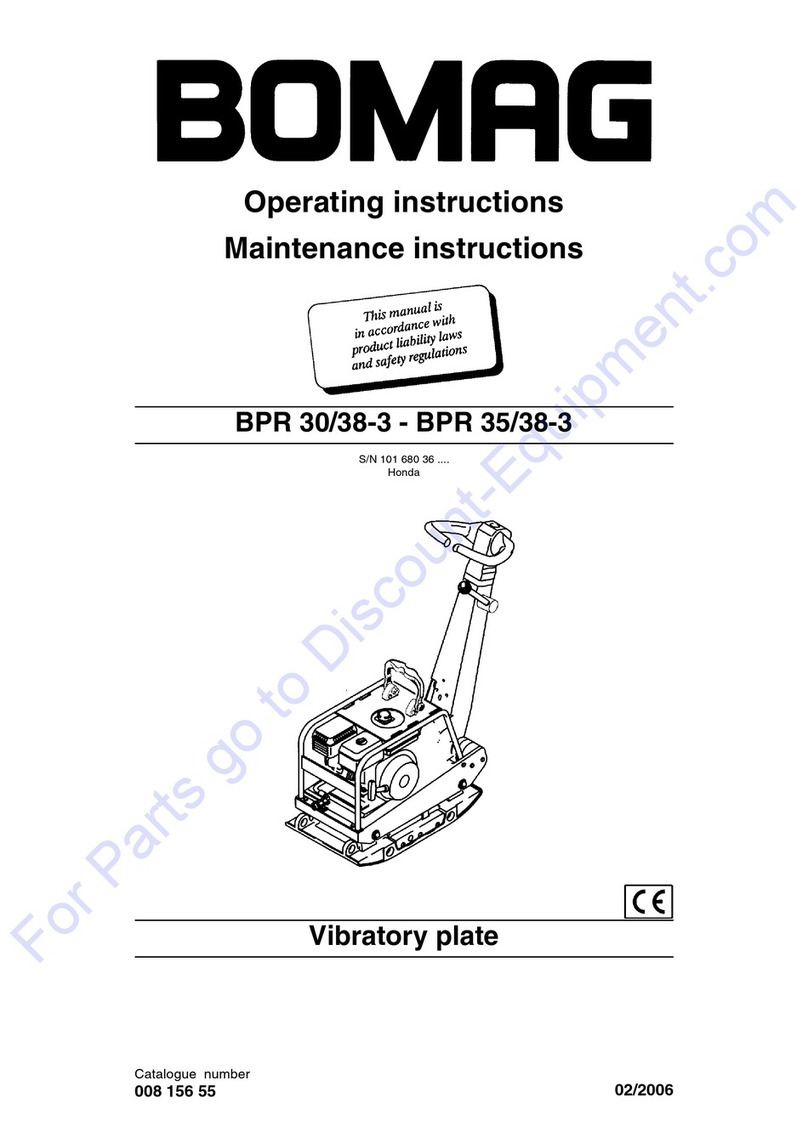ilco 008B User manual

INSTRUCTION MANUAL
IMPORTANT! Read these instructions before you use your new 008B Key
Machine. Ensure that all safety recommendations are followed! See page 2 for
instructions.
Amember of the Kaba Group
www.kaba- ilco.com

2
This manual is registered and applies specifically to the
machine which carries this serial number. It properly
identifies your model and assures you will receive correct
parts, if and when you require replacement parts. Retain
this manual in a safe place. It’s the only one of its kind. If
ownership of this machine is transferred, this service
manual should accompany the machine.
When seeking service information about this machine,
refer to Model No. 008B and the part number desired
(see pages 6 to 8). Note that many parts are not
interchangeable with other KABA ILCO machines.
CONTENTS
Warranty..................................................................................2
Safety Information .................................................................3
Introduction............................................................................4
Unpacking..............................................................................4
Operating Parts (Illustrated)..................................................5
Operating Parts Identification (Names and Part Numbers) ..5
Exploded View........................................................................6
Exploded View Parts List.......................................................8
Proper Key Cutting Techniques............................................... 8
How to Duplicate Keys..........................................................9
The Cutting Operation.........................................................10
Replacements and Adjustments..........................................11

3
IMPORTANT - Please read carefully before operating machine.
Safety begins with education, and continues with proper
application. All personnel who operate your machine
should read the supplied Operator’s Manual for
information on how to properly operate it. The likelihood
of accidents and miscuts will be greatly reduced.
General Safety
• Safety glasses must be worn to reduce the possibility
of eye injury while operating or in the immediate
vicinity of key cutting equipment.
•Always turn machine off before making adjustments or
inserting or removing keys.
•Machine should be located in an area accessible only
by authorized operators. Location must be such that
customers and other personnel are not subject to
potential injury from “flying chips”.
•Do not defeat safety features built into your machine.
Removal or modification of safety shields, cutter
guards, and other safety devices should be strictly
forbidden.
• At no time should the mechanically-driven parts of the
machine be touched while it is in operation. The
operator should take care to ensure that loose-fitting
clothing, long hair, etc. are kept from the area of
machine operation.
•Your machine has been specially designed and built
for key cutting purposes only and should be operated
according to the Operator’s Manual. All other uses are
strongly discouraged as potentially dangerous, and
should not be attempted! Such use will immediately
void the machine’s warranty.
•Some states have specific age restriction concerning
the operation of certain types of equipment. Check
local and state ordinances for compliance.
Electrical Safety
• (120 Volt models) Your machine is designed to
operate using 120 Volt A. C. 60 Hz. electrical current.
It is supplied with a three-prong power plug which
should be used with a properly grounded three-prong
outlet only. Do not defeat the safety purpose of the
plug by modifying or using with non-grounded outlets!
•Toreduce risk of fire or electrical shock, do not expose
or operate machine in damp or wet locations.
• Electrical problems should be referred to qualified
repair technicians. If the machine is under warranty,
contact KABA ILCO at the address printed on the
cover. (KABA ILCO also offers repair service for out-
of-warranty machines. Contact KABA ILCO for
details.)
•Always unplug the machine before removing the hood
or changing the cutter wheel.
Grounding Instructions
• In the event of a malfunction or breakdown, grounding
provides a path of least resistance for electric current
to reduce the risk of electric shock. This machine is
equipped with an electric cord that has an equipment-
grounding conductor and a grounding plug. The plug
must be plugged into a machine outlet that is properly
installed and grounded in accordance with all local
codes and ordinances.
•Do not modify the plug provided - if it will not fit the
outlet, have the proper outlet installed by a qualified
electrician.
• Improper connection of the equipment-grounding
conductor can result in a risk of electric shock. The
conductor with insulation that has a green outer
surface (with or without yellow stripes) is the
equipment-grounding conductor. If repair or
replacement of the electric cord or plug is necessary,
do not connect the equipment-grounding conductor to
a live terminal.
•Check with a qualified electrician or service personnel
if the grounding instructions are not completely
understood, or if in doubt as to whether the machine is
properly grounded.
• Use
only 3-wire extension cords that have 3-prong
grounding plugs and 3-pole receptacles that accept
the machine’s plug.
• Repair or replace damaged or worn cords
immediately.
WARNING – SAFETY NOTICE

4
Technical Data
Power Supply: 230V – 50Hz
120V – 50/60Hz
Maximum Absorbed Power: 230V:2Amp. 160Watt
120V:4Amp. 160Watt
Cutter Motor: Single Phase and Speed
Cutter: HSS Steel
Tool Speed: 8000 rpm
Mass (Weight): 4.5 Kg (10 lbs)
Noise Level: Less than 70db(A)
Graphics on the 008B Machine
Obligatory use of safety
goggles
Read instructions before
use
• At no time should the mechanically-driven parts of the
machine be touched while it is in operation. The
Environmental Condition
Toensurethatthe bestuseismadeofthe008Bkey-cutting
machine, certainparametersmustbe borneinmind:
damp,
badly ventilated sites should be avoided.
The ideal conditions for the machine are:
-
temperature: between 10°C (50°F)and 40°C (104°F);
-
relative humidity: 60% circa;
-
room illumination: approximately 500 Lux
Rotating cutter warning Earth connection
GENERAL INFORMATION

5
Congratulations!
You’ve purchased a superior key cutting machine.
The model 008B manually operated key machine you’ve
just purchased incorporates the latest improvements in
design for key duplicating machines of its type.
The machine features two-way vise jaws designed to
accommodate virtually any standard cylinder key, limiting
the need for adapters. Even double-sided automotive
keys can be duplicated with ease. The reverse side of the
vise jaw is ideally suited to gripping these keys and is
capable of gripping them in the groove or milling for
enhanced clamping performance when necessary (see
illustration on page 9).
Accurate, portable, easy to operate and maintain, the
model 008B delivers excellent performance at an
economical price!
Unpacking Instructions
After removing your 008B key from the shipping carton, it
should be set on a level workbench and wiped free of all
rust proofing oil. The machine is adjusted at the factory
and test keys have been cut on it, but it is recommended
that you check the adjustments to make sure they have
not slipped or shifted during transit (see page 12
”Adjustment For Depth of Cut”).
Safety
The 008B has been engineered to duplicate cylinder
(paracentric) keys. It is not intended or designed for any
other purpose. The machine operator assumes all liability
when using this machine in a manner inconsistent with its
stated design purpose. Refer to page 3 for complete
safety information before operating the machine.
KABA ILCO strongly recommends the use of protective
eye glasses or goggles when operating this machine, or
when in the vicinity of the machine while it is being
operated. Protective eye wear prevents injuries! The
machine should be turned off before loading or unloading
keys.
When the key machine is operating, be careful not to
bump the vise jaw or carriage against the cutting wheel
as this will cause damage to the cutter, jaw, or carriage.
Refer to pages 6 and 7 for illustrations.
Test Keys
A series of cut keys are supplied with your machine.
These keys were cut on your machine and represent the
result of our quality inspectors work before approving
your machine for shipment. The keys are reproductions
of factory dimensioned pattern keys and are accurate to
within .002” or less. You can save these keys and use
them as standards to check the accuracy of cuts in the
keys you make. Duplicating a key and then using a key
micrometer or caliper to compare the actual depth of the
cuts on both the duplicate and the pattern key will allow
you to see if your machine is cutting too deep or too
shallow, thus indicating that an adjustment of the cutter
guide is necessary.
Bench Mounting
The model 008B is designed to be portable and thus
easily moved from location to location as the need arises.
There is however, a provision for securing the machine to
a work bench or other suitable mounting surface. Simply
install the supplied wood screws through the 3
countersunk holes on the top surface of the machine
base when a more permanent installation is desired.
INTRODUCTION / UNPACKING

6
Operating Parts Identification
Part No Identification
008-1
008-3X
008-8
Carriage
Vise Jaw Assembly (2)
Anatomic Knob (2)
008-23 Carriage Shaft
008-38 23RF Cutter
008-49 Cutter Guide (stylus)
008-55 Adjusting Screw
008-56 Key Gauge
008B-86 Safety Hood
008-34 Deburring Brush
008-48 Drive Belt
OPERATING PARTS

7
EXPLODED VIEW

8
EXPLODED VIEW

9
Refer to pages 6-7 for illustration
Ref. Part No. Description Ref. Part No. Description
1008-1 Carriage 55 008-55 Adjusting Screw
1X 008-1
X
Carriage
A
ssembly 56 008-56 Key Gauge
2008-2 Carriage Stud 58 008-58 Key Gauge Shaft
3X 008-3
X
Vise Jaw
A
ssembly 60 008-60 Key Gauge Screw (M4X12)
4008-4 Vise Jaw Spring 62 008B-62 Off/On Power Switch
6X 008-6
X
Washer (ID8XOD24X2) 65 008-65 Main Base, Machined
8008-8
A
natomic Knob 73 008-73 Key Gauge Lock washer, (M4)
20 008-20 Cutter Shaft Bushing 74 008-74 Safety Hood Screw, (M5x10)
23 008-23 Carriage Shaft 75 008B-75A 115V Motor Assy. (008A version)
36 008-36 Cutter Shaft Screw (M5x19 LH) 76 008-76 Motor Mounting Screw (M5x14)
37 008-37 Cutter Spacer 77 008-77 Set Screw (M5x6)
38 008-38 23RF Cutter 79 008-79 Key Gauge Spring
40
41
43
008B-4
0
008-41
008-34
Cutter Shaft
Cutter Shaft Pulley
Deburring Brush
86
160
175
176
008B-86
008-160
008-175
008-176
Safety Hood/Belt Guard
Caution Label
Mounting oval head wood screw, (M5x45)
Cutter Guide Pin
47 008-47 Motor Pulley 177 008-177 Safet
y
Hood Washer
48 008-48 Drive Belt NS 008-IM Instruction Manual
49 008-49 Cutter Guide, (stylus) NS 12V motor with connecting cable
53 008-53 Binding Washer NS 008A-66 Main Base, machined
54 008-54 Cutter Guide Binding Screw
Proper key cutting techniques
Even though your 008B key machine is designed to make
key cutting efficient and accurate, operator skill is
important. The actual mechanics of placing keys within
the vise jaws is simple to learn, but there are some basics
that must be followed. A properly adjusted key machine,
used by someone who ignores good key cutting
techniques will NOT produce a good key. The way a
person clamps a key into the vise jaws is critical to the
accuracy of the duplicated key.
Remember - the real purpose of a duplicate key is to
operate the lock for which it was intended. If customers
return keys, you should reexamine your cutting
techniques and adjustment of the machine.
Here are some important operating tips:
1. Vise jaws - clean them regularly so that no metal chips
lie under the keys. It is essential that both keys lie flat
across the entire width of each vise jaw. Neither key
should be tilted.
2. Do NOT use pliers or other tools to tighten the vise
jaws. Firm hand pressure is sufficient.
3. Keep the carriage shaft free of metal chips. A thin film
of oil can be applied to it. The carriage should be free
to move without binding.
4. NEVER touch the shoulder of a key to the side of the
cutter guide. This will cause the shoulder of the key
blank to touch the side of the cutting wheel. When this
happens, some of the metal will be cut away from the
shoulder of the key blank. If the resulting duplicated
key is duplicated two, three, four times over, an error
will accumulate and cause a non-operating key. Do
not grind away the shoulder.
5. Don’t run the cutter into the vise jaw; this will dull the
cutter, and reduce cutter efficiency.
6. Keep the cutter clean. Don’t let any foreign objects or
instruments blunt it. This cutter is a precise cutting tool
and should be handled with care.
7. Lubrication of moving parts is important. The carriage
spindle should be lubricated with a thin film of oil,
removing excess with a clean dry cloth. The
lubrication procedures should be performed every 2-3
weeks depending upon machine usage. (5-7 drops of
a lightweight machine oil such as “3-in-1” or equivalent
is sufficient.)
EXPLODED VIEW PARTS LIST

10
Using the two-way vise jaws
Your 008B machine is equipped with versatile Super Jaw
1 two-way vise jaws. Their unique clamping surfaces will
securely grip virtually any typical cylinder key, while
reducing the need for adapters.
The vise jaws have two clamping surfaces; standard and
“X”. The standard position is identified by a 1⁄4” wide slot
milled into the vise surface. The “X” position is identified
by the presence of the letter X stamped on the upper half
of the vise jaw. When choosing which position to use
observe the following guidelines:
Standard position — for holding regular cylinder keys
such as house keys, single-sided automotive keys,
padlock keys, with one or two shoulders. Also used for
“Ford style” double-sided keys which do not have a
groove along the center of the key blade.
X position — Ideal for holding most double sided
convenience keys used on many current automobiles.
Grips these keys by the grooves rather than the blade
edge where the cuts are located (see fig. 1).
To rotate the vise jaws from one position to the other,
loosen the wing nuts three or four turns from the “closed”
position. Using the thumb and forefinger, grasp the
bottom section of each vise.
Lift this section up and
free of the carriage.
Rotate the vise jaws one-
half turn and reseat lower
section into groove of
carriage (see fig. 2). Both
vise jaws must be rotated
to the same position;
standard or X!
How and when to use straight wires
Occasionally, you may encounter keys with rounded or
wide milling (grooves) that tend to tip in the vises when
the wing nuts are tightened. If this occurs, you should
position a “straight wire” (supplied in the machine’s tool
pack) into the milling or groove closest to the back of the
key (see fig. 3A). With the straight wire positioned as
shown, insert the key in the vise and tighten the wing nut
to secure it in place. This will prevent tilting from
occurring. An alternate method is to use the “X” side of
the vise jaws to grip the milling of such keys.
Some narrow keys with deep cuts require the straight
wire to be placed under the key. This raises the key out
from the vise to prevent the cutter from contacting the
vise jaws when making the deep cuts (see fig. 3B).
Figure 3A
Figure 1
HOW TO DUPLICATE KEYS
Figure 2
Lift…
rotate…
reseat
Figure 3B

11
Aligning keys in the vise jaws
Keys with shoulders
WARNING: Do not install or remove keys unless the
off/on switch is in the off position.
Both the pattern key and the key blank must be properly
aligned and securely clamped in the vise jaws. Todo this,
slide the machines’ carriage assembly towards the right
and position the appropriate key blank in the carriage’s
RIGHT vise jaw with the head of the blank pointing to the
left.
Ensure that the shoulder of the key blank is located
approximately 1⁄8” to the left of the vise jaw‘s left edge.
Holding the key blank firmly and level against the jaw,
tighten the wing nut. Position the pattern key in the
carriage‘s LEFT vise jaw in a similar manner only this
time allowing a 1⁄4” gap between the shoulder of the key
and the edge of the vise jaw.
Next lower the key gauge and position the carriage so
that the left edge of the gauge’s RIGHT prong contacts
the edge of the key blank’s shoulder (see fig. 4A).
Loosen the wing nut securing the pattern key and
reposition the key so that its shoulder is in contact with
the left edge of the LEFT prong of the key gauge.
Check to ensure that the pattern key and blank key‘s
shoulders are snug against the key gauge and both keys
positioned level (not tilted) in the vise jaws. Retighten the
wing nut.
Aligning keys in the vise jaws
Keys without shoulders
On keys such as the Ford double-sided key, which do not
have conventional shoulder, the tip of the key is used as
the aligning point (see Fig. 4B). Clamp the blank key in
first and move the machine carriage to the left. Lower the
key gauge and position the carriage so the tip of the Ford
key touches the key gauge. Install and align the pattern
key in the left vise jaw in the same manner.
“Best” and “Falcon” type keys do not have a conventional
shoulder but have a recessed tip and the key gauge is
used to align the recessed tips. After clamping the blank
key, the carriage is moved to the left so that the key
gauge can be lowered to contact the recessed tip
surface. The pattern key is aligned in the left vise jaw and
positioned to contact the edge of the key gauge in the
same manner (see Fig. 4C).
Figure 4B
Tip
Figure 4A
Shoulder
THE CUTTING OPERATION
Figure 4C Recessed tip

12
General Operating Sequence
WARNING: Do not install or remove keys unless the
off/on switch is in the off position.
1. Rotate both vise jaws to the station suitable for the
key being duplicated.
2. Insert the blank key and pattern key into the vise jaws
using the appropriate method described under
“Aligning Keys in the Vise Jaws”. Be sure that both
keys are laying level in the vise jaws and are not tilted.
3. Lower the key gauge to align the keys using an
appropriate method as described under “Aligning
Keys …” found in the previous section (see page 10).
4. After the keys are aligned, return the gauge to its “up”
position.
5. Press the off/on switch to the “on” position.
6. Lift the carriage with both hands.
7. Move the carriage to line up the cutter guide with the
shoulder of the pattern key, then shift slightly away
from the shoulder. Do not permit the cutter to touch
the shoulder of the key blank.
8. Press in on the carriage, while guiding it to the left.
Carefully trace the cuts of the pattern key with the
cutter guide.The cutter will make a corresponding cut
in the key blank. When the cut closest to the tip of the
pattern key has been traced, retrace the cuts by
guiding the carriage to the right. This will clear away
any metal not removed during the initial pass over the
key blank.
9. Press the off/of switch to the “off” position. Remove
the duplicate key. Press the switch back to the “on”
position, and lightly contact the duplicate key against
the deburring brush to remove any residual material
from the key cuts.
10. Operating Tips - When duplicating a key, avoid an
irregular jerking motion in the movement of the
carriage.Acquire a smooth steady motion, using both
hands on the carriage to guide it. Apply the same
degree of pressure each time a key is duplicated.
Excessive pressure may cause “over-cutting”. It is
sometimes best to practice on a few keys until the
operator learns to impart a steady, uniform pressure
to the carriage.
Replacing the Cutter -
UNPLUG MACHINE BEFORE PROCEEDING
The 23RF cutter used on this machine is 21⁄4” in diameter,
.250” thick (1⁄4”) and has a 1⁄2” hole. It’s a milling cutter,
made out of high speed steel. It has a flat left side, which
is excellent for making deep cuts, when these cuts are
next to the shoulder, such as on GM, Chicago, etc. No
warranty is placed on the cutter, operators should treat it
with care and avoid harsh usage. Do not force the
carriage up, causing the key blank to bang into the cutter,
and do not apply heavy pressure when cutting. Also, do
not let the cutter run into the vise jaw; this will dull the
cutter quickly.
As with any metal cutting instrument, the 23RF will dull
with usage. There are three ways to tell when a cutter
is dull and requires replacing:
1. Time - a dull cutter takes longer to make the cuts.
2. Sound - a dull cutter will emit a shrilly sound as it runs
across the key blank.
3. Burrs - a dull cutter will not cut away the metal but will
roll it away. When this occurs, there will be a buildup
of metal burrs on the underside of the key. If this
buildup is heavy, the cutter is dull. A sharp cutter
leaves little or no burrs.
To replace the cutter:
1. Remove screw which holds hood in place and remove
hood.
2. To remove the cutter, loosen cutter shaft screw using
allen wrench supplied with machine. IMPORTANT:
This is a left hand screw. Remove by turning in a
clockwise direction. Screwdriver slot is provided on
the opposite end of the shaft to aid in removal.
3. Remove old cutter and replace with new one. Be
careful to replace washers properly. Diagram below
shows placement of washers with standard 23RF
cutter and optional slotter.
REPLACEMENTS AND ADJUSTMENTS
23RF cutter
Slotter (optional, order 27X kit)

13
Adjusting for depth of cut
To ensure safety, UNPLUG machine from its power
source before adjusting for depth of cut. It’s imperative
that the key guide and the cutter be in the same plane,
that is, aligned to each other. If the cutter guide protrudes
further than the cutter, the resulting cuts in a key blank
will be too shallow and the duplicate key will not work.
Likewise, if the cutter guide is behind the cutter, the cuts
in the key will be too deep (see Fig. 6).
To check the depth adjustment, insert two identical key
blanks into the vise jaws, setting them flat in each vise. It
is not necessary to align the blanks. Then, raise the
carriage, positioning the left blank against the cutter
guide and the right blank against the cutter. Next, turn the
machine pulley by hand and note the right key blank. The
cutter should just barely graze the key blank when the
adjustment is correct.
No cutter is perfectly round so make one complete
rotation of the cutter before changing adjustment. There
will be a high point on the cutter; the adjustment should
be made to the high point. If the cutter does not touch the
key blank after one rotation, proceed to change the
adjustment.
To adjust cutter guide, loosen set screw on top of the
guide. With a flat screwdriver, turn adjusting screw in (to
increase depth of cut) and/or out (to decrease depth of
cut). Again, proper adjustment is achieved when the
cutter barely grazes the key blank.
Maintenance
1. The carriage spindle should be lubricated periodically
by wiping lightly with an oily rag. The cutter shaft is
lubricated by the oil impregnated bronze bearings.
After extended use, these bearings should be
lubricated with a light machine oil applied to their end
to assure continued smooth operation.
2. Keep the model 008B clean. The cutter should be kept
free of filings and dirt. A wire brush may be used for
this purpose, being careful not to chip or dull the
cutter. The motor should also be free of filings.
Compressed air is recommended for cleaning the
motor.
3. The machine should be picked up by the base, not the
carriage … as tempting as it seems. Alignment of the
carriage is critical for accurate duplication of keys and
this type of handling is not suggested.
Replacing the drive belt
UNPLUG MACHINE BEFORE PROCEEDING
1. Remove screw which holds hood in place and remove
hood.
2. Using allen wrench supplied with machine, loosen
both set screws located in cutter shaft pulley.
3. Slide cutter shaft to the left and remove cutter shaft
pulley and belt.
4. Place new belt and pulley in position and slide the
cutter shaft back to the right. Before tightening (2) set
screws in cutter shaft pulley, make sure cutter and
pulley are snug against bronze bearings in left
supporting post. This insures minimum end play.
Replacing the Deburring Brush
UNPLUG MACHINE BEFORE PROCEEDING
1. Remove safety hood for easier access.
2. Grasp existing deburring brush (using a shop cloth will
provide added grip).
3. Loosen and remove retaining bolt to release existing
brush.
4. Install new brush and reinstall/retighten retaining bolt.
Cleaning
Your machine should be kept clean of all filings and dust.
The most critical areas are the carriage jaws and shafts.
Aone inch paint brush is ideal to brush these areas of the
machine. The shafts should be wiped periodically with a
lightly oiled cloth. We suggest brushing the jaws often as
even a single filing can alter the accuracy of the machine.
Figure 6
REPLACEMENTS AND ADJUSTMENTS
Table of contents

